Quadricentennial Challenge | |
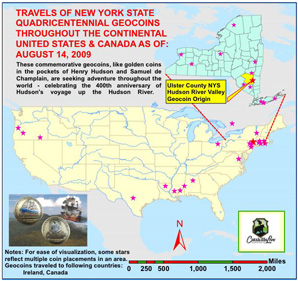 Catskills Live! Trails & Wilderness Association issues a challenge to all — venture forth and seek all 15 Quadricentennial Challenge geocaches. Go to many great places throughout Ulster County — visit the shores of the Hudson, feel the cool air in an historic cement mine, enjoy our small parks, ride on our rail trails, summit two Catskill peaks, and savor the breath-taking view from Gertrude's Nose in Minnewaska State Park Preserve. Bask in our county's treasures with family and friends, exercise your body, and build lasting memories. Specially minted commemorative Quadricentennial geocoins are being released from Challenge geocaches in celebration of the 400th anniversary of the exploration of New York State by Henry Hudson. All 15 Challenge caches will be available this summer. Funding for the Challenge was provided by Ulster County and the Hudson River Valley Greenway. | |
Sloan Gorge Preserve | |
The Sloan Gorge Preserve is located in northeastern Ulster County, New York State. Shortly before his death, artist Allan Edward Sloan donated this 88-acre preserve to the Woodstock Land Conservancy. It opened to the public in June 2007. |  |
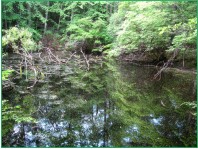 An elongate, oval, 1.5 mile loop trail makes the mixed hardwood and coniferous forest, vernal pools, seasonal stream, and deep bedrock gorge available to all. This gem of a preserve is well-suited for hiking, birding, wildlife observation, nature study, and educational activities. | |
The Sloan Gorge Preserve is located in northeastern Ulster County, New York State. Shortly before his death, artist Allan Edward Sloan donated this 88-acre preserve to the Woodstock Land Conservancy. It opened to the public in June 2007. |  |
Old Bluestone Quarries | |
Following Henry Hudson's opening of the Hudson Valley, one of the industries to develop in the Catskill Mountain region was bluestone quarrying. The Sloan Gorge preserve stands out for its excellent bedrock exposures of sandstone and shale. Sandstone or ³bluestone² was quarried here for use locally as flagstones and in walkways because of its well-defined horizontal bedding planes that were easy to separate into layers a few inches in thickness. In many places scattered throughout the preserve, bluestone debris remains as testimony to the late 1800s and early 1900 quarry days. | 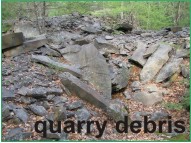 |
 Careful examination of the debris reveals lines of drill holes hand-pounded with star drills and split with half-round wedges. Few people realize that the art of splitting large rocks also required constant scoring of a ³guide² line around the block to be split. This guideline was regularly scored with a chisel and sledge hammer during both the drilling and splitting process. It served to help align the break line and generally followed the same direction on bedrock throughout quarries — a direction found through experience to be best aligned for breakage with the orientation of the internal crystalline structure of the bedrock. | |
Sloan Gorge | |
Sloan Gorge was carved by glacial meltwaters cascading off the flank of Overlook Mountain and the Catskill Front, flowing north-northeast to south-southwest through the gorge. | 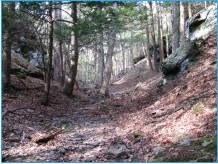 |
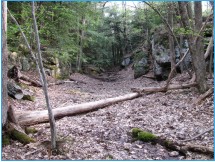 This deeply entrenched gorge, while mostly dry today, preserves an important chapter in the recent geologic history of the Catskills region. | |
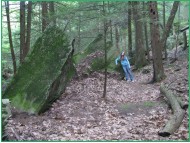 Robert Titus provides an excellent interpretive geology trail description of the gorge, which has been correlated with numbered markers along the trail, for all to enjoy. | |
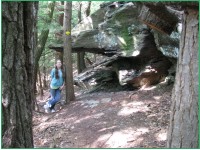 Detailed discussions are available in trailside brochures and online at the website of the Woodstock Land Conservancy. | |
The Gilboa and Ashokan Forests — the First Forests on Earth | |
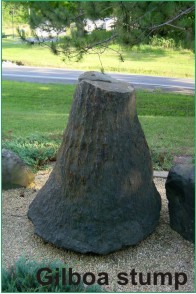 The carving of Sloan Gorge by ancient stream channels is just one of many chapters in the geologic evolution of the Sloan Gorge Preserve and surrounding area. Perhaps the most geologically exciting aspect of the gorge and surrounding area is the fact that the bedrock layers here were host to THE oldest fossil tree forest on earth. Geologists worldwide seek and study early plant and tree remains. Before publication of this geocache description, the oldest recognized, described, and published forest was the Gilboa Forest (approximately 380 million years old), recognized for its upright stumps and insect fauna found near Gilboa, New York, roughly 29 miles north-northwest of Sloan Gorge Preserve. | |
Two stumps from the Gilboa Forest, found in the Moscow Formation, are illustrated here. Paleontologists have discovered evidence of fossil animals including earthworms, centipedes, spiders, and insects associated with these early plant remains. | 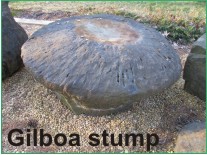 |
In 1995, geologist Paul Rubin recognized that younger geologic beds of the Catskill delta contained an even older fossil forest. As such, it is important to place the Gilboa forest in geologic perspective relative to the bedrock in Sloan Gorge and nearby environs. The Gilboa area fossils generally span elevations ranging roughly from 960 to 1120 feet above mean sea level (msl), representing three successive forests. The base of Sloan Gorge lies close to 700 feet msl. The same geologic formation present in Sloan Gorge also extends northward, westward, and southward to and beyond Olivebridge, through part of the Ashokan Reservoir and down through the Ashokan Field Campus to an elevation of about 320 feet msl. Portions of fern-like trees are found throughout this region, all hundreds of feet lower in elevation than those in the Gilboa Forest. | 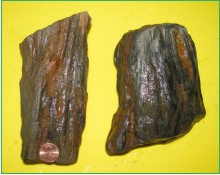 |
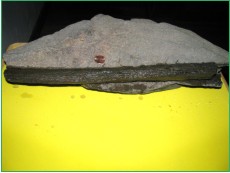 Geologic beds, like layers in a cake, are oldest from the bottom up. The same is true of these sediments transported off the flank of the former Acadia Mountains that once rose further east to elevations of tens of thousands of feet. Thus, our local sandstones and shales that comprise the Panther Mountain Formation are significantly older than those of the Gilboa forests known in the overlying Gilboa Formation, possibly predating them by about 10 million years. | |
Examples of bark, limb, and frond imprints and casts of these primitive trees, the first that ever grew on earth (approximately 390 million years ago!), are depicted here. Many were found at an elevation of about 570 feet msl, some including downed tree imprints extending more than nine feet in length. These tree segments are thus from one or more of the earliest forests on earth that later evolved and extended westward into the Gilboa forests along a swampy, tropical, coast of the inland Catskill Sea some 390 million years ago — over 160 million years before the appearance of the first dinosaurs. We might well name this region the “Ancient Ashokan Forest”! | 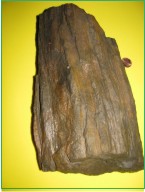 |
 Keep your eyes open as you walk throughout Sloan Gorge, the Catskill Mountains, and particularly near the base of the Catskill escarpment. | |
You may find imprints and casts of some of the oldest fossil trees on earth. |  |
Picture yourself walking amidst tall fern-like trees alongside braided rivers cascading westward off the jagged Acadia Mountains. | 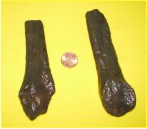 |
The Cache | |
This is a three stage multi-cache. Each stage is well-spaced along and close to the loop trail such that the successful geocacher will be sure to see the entire Sloan Gorge Preserve. Be sure to bear left at the trail junction beyond the half-hip trusses. Two stages must be found before the third, treasure-laden, cache is found. | 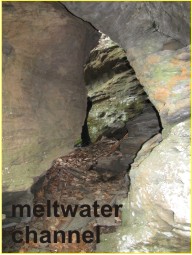 |
 Each cache stage consists of a 2-liter cylindrical poly bottle. The final cache is filled with kid-friendly items and, initially, four NYS Quadricentennial Challenge geocoins designed to travel throughout the world. This geocache was approved by the Woodstock Land Conservancy. | |
Parking | |
| Access to the cache is available from a single parking location. Located at the foot of Overlook Mountain on the Woodstock-Saugerties town line on Stoll Road near its southwestern end close to Goat Hill Road (Ulster County). The Sloan Gorge Preserve is open from dawn to dusk. Due to rugged trail conditions and the wishes of the Woodstock Land Conservancy, geocaching is not permitted after dusk. Look for the Woodstock Land Conservancy kiosk. Parking for the Preserve is available only in the Sloan Gorge parking lot. | |
Please Cache In and Trash Out! | |